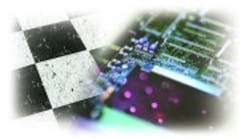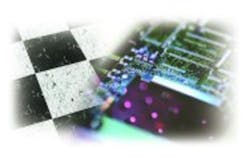The process of selecting, installing, and maintaining ESD-safe flooring is complex—a science, not an art. All the other important choices in static control at a facility, such as workstations, seating, wrist straps, monitors, and ionizers, are limited in effectiveness if the wrong floor is chosen or if the surface isn’t maintained properly.
Selection Factors
Several factors must be considered, depending on how the area will be used. The process starts by establishing the resistive characteristic. Do you need a dissipative surface to accommodate a wide variety of users or a conductive floor where personnel will wear static-control footwear?
Resistance in the range of 104 W to 1011 W is a dissipative floor, and a resistance of <104 W identifies a conductive surface. These specifications are defined by ANSI/ESD S7.1-94, Floor Materials—Resistive Characterization, with point-to-point resistance generally checked at 12% and 50% relative humidity (RH) with a 100-V potential applied through 5-lb probes spaced no more than 20² apart.Is the resistance of the flooring you are considering within the desired dissipative or conductive limits? Is it consistent across the entire floor? Will it be at that level permanently with the expected traffic and frequent and proper care?
“Two other significant items sometimes are overlooked,” according to Dixon Gleeson, market development manager at the 3M Electronic Handling and Protection Division. “These are charge generation (propensity) and charge drainage (static decay).”
Charge generation identifies the tendency of the flooring to build up a static charge on a person. Using a charge analyzer, it typically should be measured at 70°F and about 20% RH on someone wearing various conductive and dissipative footwear, including leather and Neolite, with and without foot and heel grounders. The test can be conducted with an electrometer and ionization source and the result expressed in volts.
Charge drainage measures the time it takes for the flooring to drain a static charge from a person wearing conductive footwear. To prepare for the tests, three samples of flooring are preconditioned at different levels of humidity and temperature. The test is run at 73°F and about 50% RH with an applied potential of 5,000 VDC. Since no ESD Association standard relates to this test, it generally is based on FTM 101B, Method 4046, an evaluation method for packaging materials.
For areas with only foot traffic or lightweight carts, you have several choices. The typical options are vinyl, rubber, epoxy, carpet, and wax. In heavier-use applications, more durable materials generally are the choice. These include vinyl tile, rubber tile, and self-leveling epoxy.
A clean room presents a different challenge. The environmental purity usually requires homogeneous materials that have low outgassing, don’t shed, and can be cleaned with simple, noncontaminating products and procedures. If the clean room has a raised floor, the manufacturer should apply the ESD protection before the floor panels are installed.
“Beyond the static-control properties,” Mr. Gleeson of 3M cautioned, “you should be concerned with durability and appearance. Is maintenance straightforward and relatively inexpensive?
“Installation conditions are important, too,” he continued. “Is the flooring easily and quickly installed? How long will work in surrounding areas be disrupted while installation is in progress? How long must the flooring system cure before it can be used?
“Finally, the expected life of the floor should be considered. Cost of the flooring is important, but the probable cost per year of anticipated use is the important bottom line,” Mr. Gleeson concluded.
Epoxy Flooring
The epoxy floor is expensive but provides a uniform surface and color. Also, it has an industrial strength and can handle heavy traffic.
Typically, the basic epoxy floor is a three-layer system. “Each epoxy-formulated coating incorporates the appropriate conductive media,” explained C. Karl Sauereisen, vice president of Sauereisen. “A floor consists of an insulating sealer, a conductive or dissipative layer, and a protective topcoat.”
In the installation, the bottom layer is a sealing process that insulates the natural conductivity of a concrete substrate. The moisture content in concrete flooring varies widely with age and season, and the water must not be allowed to affect the conductivity of the layers. For optimum adhesion, the concrete should have a surface profile resembling coarse sandpaper. A shot-blast machine is the best way to prepare the surface.
Depending on the application, the middle layer is a conductive or dissipative primer, epoxy loaded with carbon black. Small copper strips about 2² long are integrated with the primer near a column ground.
The working surface, a white or colored topcoat containing fine carbon fibers, provides an electrical pathway to the primer. The most popular coating is 50 mils thick and strong enough for heavy forklifts, but thinner coats are used where traffic is light. The coating is applied by airless spray or by pouring and spreading the polymer.
Slip resistance is not specified by the ESD Association, but traction is an important safety item. Mr. Sauereisen recommends the James Shoe Machine Test, with expected coefficients of friction ranging from 1.0 on a wet surface to 1.2 on a dry one. In especially challenging environments, the installer can spread conductive anthracite aggregate to improve the performance.
Vinyl Tile
An alternate solution, vinyl tile is less expensive than a poured epoxy floor. The color and the electrical characteristics are uniform.
“Solid vinyl tile has good internal conductivity,” Hugh Richard Scott, a marketing specialist at VPI, said. “Even in areas with heavy wear, the dissipative performance does not deteriorate with use. The tile resists chemical stains and can be heat-welded for seamless installations, making it easier to clean.
“The base concrete flooring should be installed over a moisture-retardant membrane,” he continued, “and must not have high alkalinity. The adhesive, an integral part of the static-control program, must be conductive. Copper grounding strips should be installed for every 2,000 to 2,500 square feet of tile.”
Floor finishes when applied to dissipative tiles can control static generation even at 15% RH. One such finish, ACL Staticide® spray, is an acrylic polymer with a static-control component in the acrylic molecule. It lasts 12 to 18 months in a typical application.
ESD Paint
ESD paint is less expensive than epoxy floor or tile. “In the past,” Darryl Allen, floor care product manager at Desco Industries, noted, “most paint was dark-colored and unattractive, but now a light gray finish with typical resistance of 105 W has become quite popular, especially with contract manufacturers. Paint can be applied easily with a brush, roller, or spray gun. When an area needs a touch-up, the coating reconnects electrically to the balance of the floor.”
Floor Care
“Any barrier between the floor system and the people using the floor will inhibit static protection,” Brett Sheldon, product manager at Stonhard, reminded us. “Dirt is a prime culprit. The floor manufacturer is the best source of advice on just how to remove dirt while preserving the floor’s electrical characteristics.”
Floor care should always have static control as the top priority. This means frequent attention and forbids the use of an abrasive cleaner, floor rinse, or a scrubbing machine.
“Proper maintenance,” according to VPI’s Mr. Scott, “includes sweeping or dust-mopping the entire floor. Soiled spots can be cleaned with a damp or wet mop, and scuffed and heel-marked tiles can be spray-buffed.”
Acknowledgements
The following companies contributed to this article:
ACL Staticide
800-782-8420
www.aclstaticide.com
Desco Industries
909-627-8178
www.desco.com
Sauereisen
412-963-0303
www.sauereisen.com
Stonhard
800-257-7953
www.stonhard.com
3M Electronic Handling and Protection Division
800-537-2799
www.3m.com
VPI
800-874-4240
www.vpicorp.com
Return to EE Home Page
Published by EE-Evaluation Engineering
All contents © 2002 Nelson Publishing Inc.
No reprint, distribution, or reuse in any medium is permitted
without the express written consent of the publisher.
June 2002

